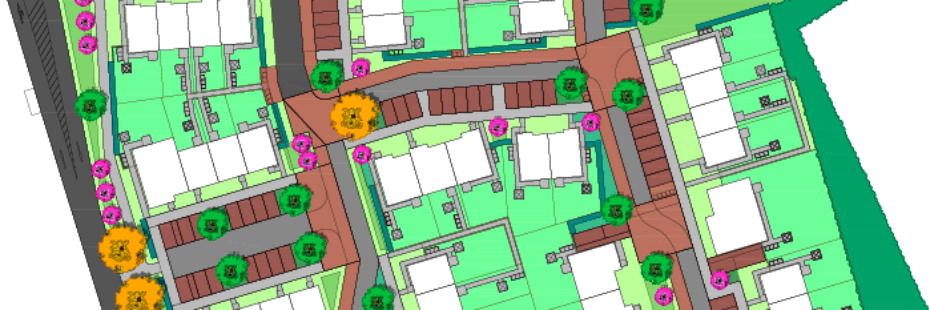Claish Farm provides a variety of housing, including homes suitable for people of working age with families and for people of any age with accessibility requirements. Analysis of waiting list demand combined with community consultation informed decisions regarding house sizes and types, with the final housing mix comprising 1, 2, 3 and 4-bed semi-detached villas and semi-detached and detached bungalows, with 7 properties in the development being wheelchair accessible.
Planning principles included ensuring links to the nearby national cycle route, integration with the town, maximising views towards the neighbouring historic garden, designed landscape, mitigation against any possible impact on the river Teith, and a high quality landscape influenced by the river's character.
A Habitat Management Plan for the wetland area to the north of the development was submitted and approved by the Planning Authority and SEPA.
An ecosystem planning strategy for the integrated management of land, water and living resources that encouraged conservation and sustainable land use was an integral part of the project.
Lovell worked closely with all key stakeholders including the National Park Planning Authority to ensure we interpreted the specific requirements correctly; a strategic working group made up of representatives from planning, SEPA, Scottish Water, SNH, Historic Environment Scotland, the local roads department and transport Scotland was formed to progress the development. Feedback from the local community and from statutory consultees at local events held by Lovell led to amendments to the design such as the use of a gateway feature for traffic calming and movement of house types within the development to improve visual amenity and inclusion of 4 bed houses.
In addition to community consultation events, and in order to aid with community engagement, a Claish Farm website was published and regularly updated. This provided easily accessible up-to-date information on the project and contact information for further queries. Other engagement included discussion with a local ecologist; this provided ideas for possible methods of increasing the wildlife value of the development. As a result, a ‘hedgehog highway’ was incorporated into the development design.
Sustainable materials were used in the Claish Farm development, such as natural stone walling and timber cladding to house elevations. A large area of greenspace was retained as a meadow grassland with a wetland area within it for local wildlife.
The Claish Farm project was challenging, with various associated abnormal costs. Lovell worked proactively with RSHA to develop various value engineering measures to bring the project within budget and achieve funding approval from the Scottish Government; the grant application including the revised costs received Government approval in May 2019.
The project achieved site start in February 2020, but was required to close a month later, due to Covid-19 lockdown measures and despite this was still delivered on time and on budget.
The project brought 30 local jobs to Callander including 14 joiners, and 6 brick layers. 2 work experience placements were also provided to pupils of neighbouring McLaren High School.
Lovell are currently working with the Ripple Retreat, a charity based in Callander that helps families of young cancer patients unwind during challenging times. We will help the Retreat provide a Glamping Pod for families, either by providing a donation or through assisting with the construction of the pod, including provision of materials.

















